外研版(2019)选择性必修 第四册Unit 6 Space and beyond Developing ideas课件(共15张PPT)
文档属性
| 名称 | 外研版(2019)选择性必修 第四册Unit 6 Space and beyond Developing ideas课件(共15张PPT) | 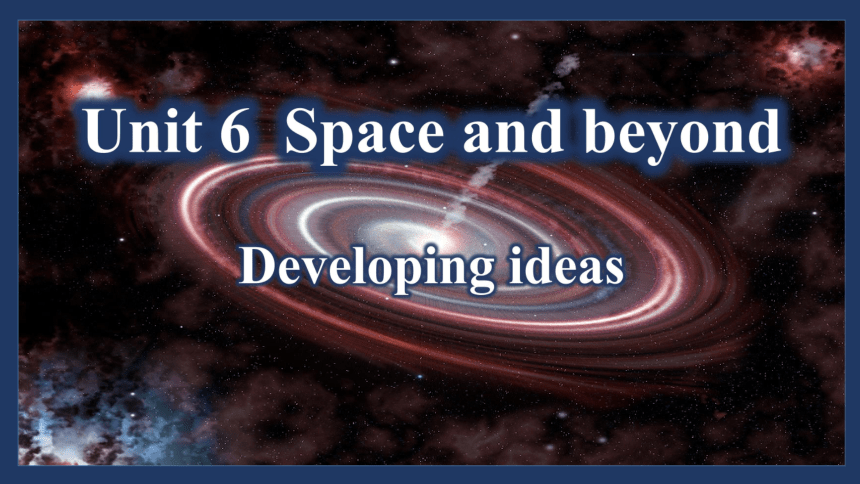 | |
| 格式 | pptx | ||
| 文件大小 | 28.4MB | ||
| 资源类型 | 教案 | ||
| 版本资源 | 外研版(2019) | ||
| 科目 | 英语 | ||
| 更新时间 | 2023-05-23 18:30:34 | ||
图片预览

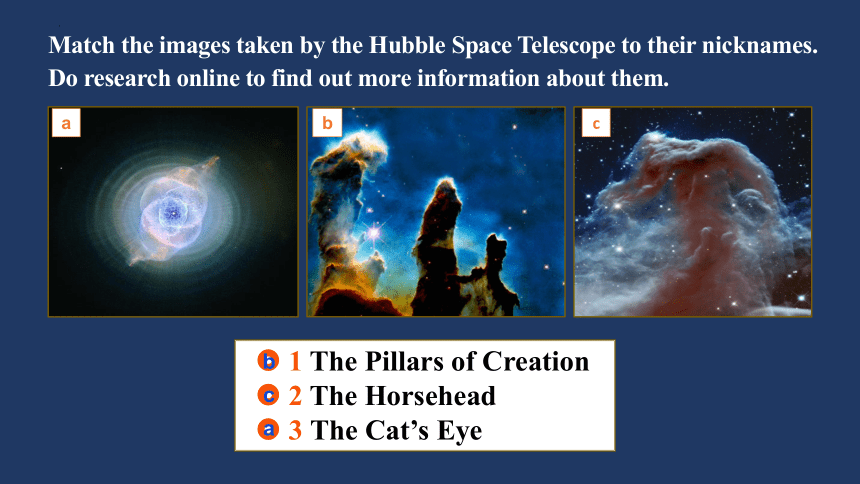
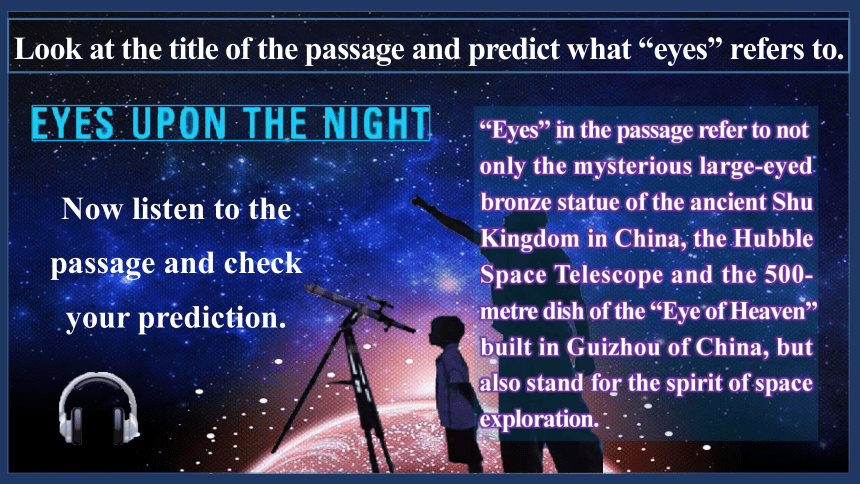
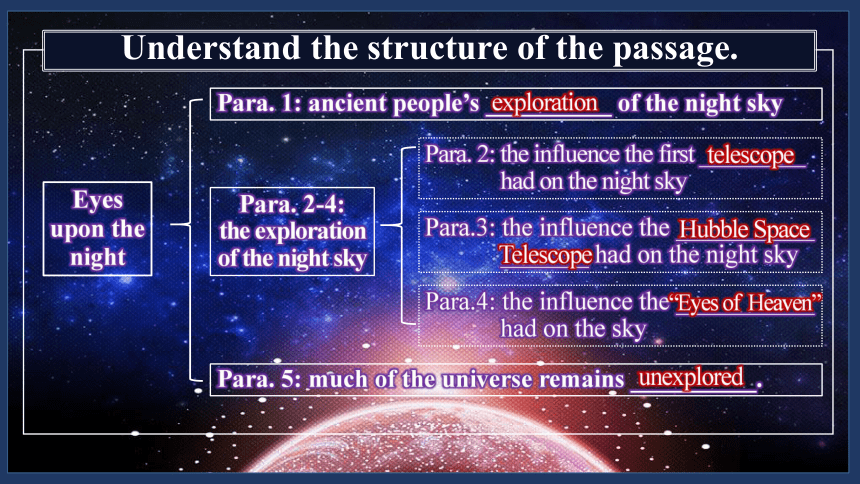
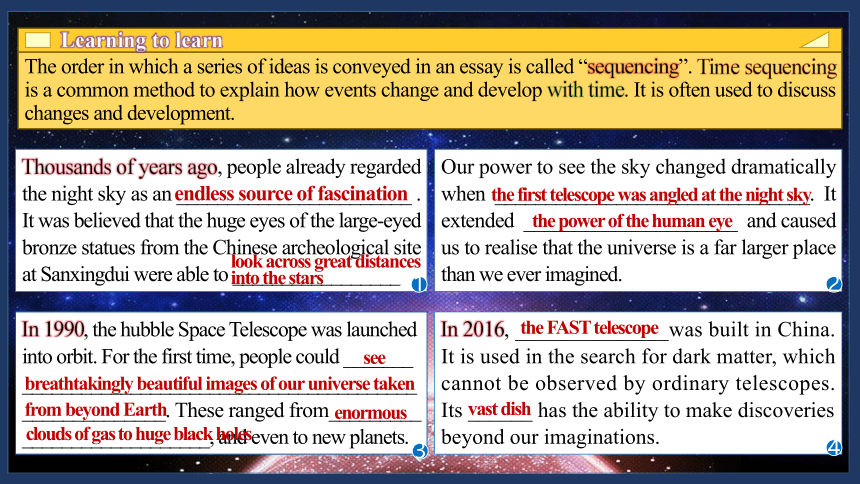
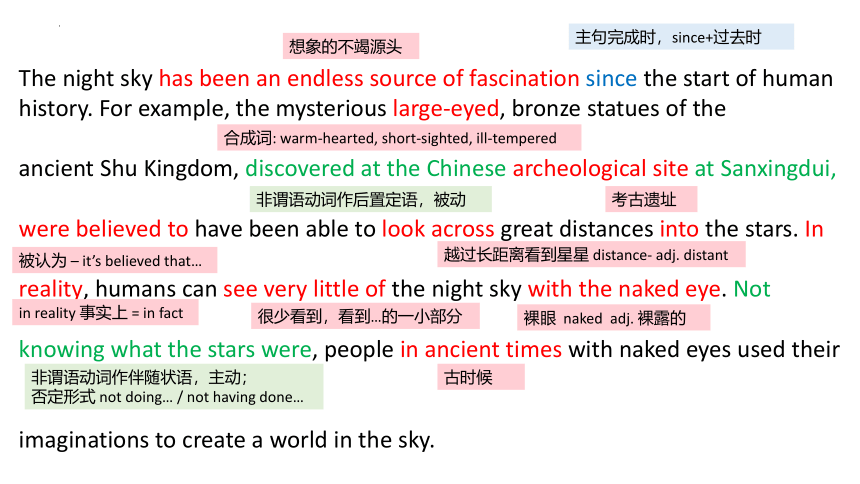
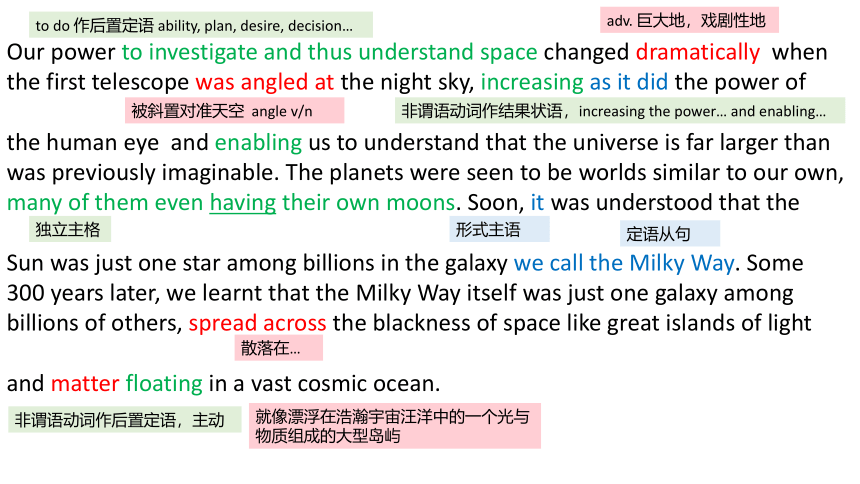
文档简介
(共15张PPT)
Unit 6 Space and beyond
Developing ideas
Match the images taken by the Hubble Space Telescope to their nicknames. Do research online to find out more information about them.
a
b
c
1 The Pillars of Creation
2 The Horsehead
3 The Cat’s Eye
b
c
a
Now listen to the passage and check your prediction.
Look at the title of the passage and predict what “eyes” refers to.
“Eyes” in the passage refer to not only the mysterious large-eyed bronze statue of the ancient Shu Kingdom in China, the Hubble Space Telescope and the 500-metre dish of the “Eye of Heaven” built in Guizhou of China, but also stand for the spirit of space exploration.
Eyes upon the night
Para. 1: ancient people’s __________ of the night sky
Para. 2-4:
the exploration of the night sky
Para. 2: the influence the first _________
had on the night sky
Para.3: the influence the ___________
_______ had on the night sky
Hubble Space
Telescope
Para.4: the influence the ___________
had on the sky
“Eyes of Heaven”
Para. 5: much of the universe remains __________.
exploration
telescope
unexplored
Understand the structure of the passage.
Thousands of years ago, people already regarded the night sky as an _______________________ . It was believed that the huge eyes of the large-eyed bronze statues from the Chinese archeological site at Sanxingdui were able to ___________________.
Our power to see the sky changed dramatically when _______________________________. It extended _____________________ and caused us to realise that the universe is a far larger place than we ever imagined.
In 1990, the hubble Space Telescope was launched into orbit. For the first time, people could _______
________________________________________
______________. These ranged from_________ ___________________, and even to new planets.
In 2016, ______________was built in China. It is used in the search for dark matter, which cannot be observed by ordinary telescopes. Its ______ has the ability to make discoveries beyond our imaginations.
endless source of fascination
look across great distances into the stars
the first telescope was angled at the night sky
the power of the human eye
see breathtakingly beautiful images of our universe taken from beyond Earth
enormous clouds of gas to huge black holes
the FAST telescope
vast dish
1
2
3
4
The order in which a series of ideas is conveyed in an essay is called “sequencing”. Time sequencing is a common method to explain how events change and develop with time. It is often used to discuss changes and development.
Learning to learn
The night sky has been an endless source of fascination since the start of human history. For example, the mysterious large-eyed, bronze statues of the
ancient Shu Kingdom, discovered at the Chinese archeological site at Sanxingdui,
were believed to have been able to look across great distances into the stars. In
reality, humans can see very little of the night sky with the naked eye. Not
knowing what the stars were, people in ancient times with naked eyes used their
imaginations to create a world in the sky.
想象的不竭源头
主句完成时,since+过去时
合成词: warm-hearted, short-sighted, ill-tempered
非谓语动词作后置定语,被动
考古遗址
被认为 – it’s believed that…
越过长距离看到星星 distance- adj. distant
in reality 事实上 = in fact
很少看到,看到…的一小部分
裸眼 naked adj. 裸露的
非谓语动词作伴随状语,主动;
否定形式 not doing… / not having done…
古时候
Our power to investigate and thus understand space changed dramatically when the first telescope was angled at the night sky, increasing as it did the power of
the human eye and enabling us to understand that the universe is far larger than was previously imaginable. The planets were seen to be worlds similar to our own, many of them even having their own moons. Soon, it was understood that the
Sun was just one star among billions in the galaxy we call the Milky Way. Some 300 years later, we learnt that the Milky Way itself was just one galaxy among billions of others, spread across the blackness of space like great islands of light
and matter floating in a vast cosmic ocean.
to do 作后置定语 ability, plan, desire, decision…
adv. 巨大地,戏剧性地
被斜置对准天空 angle v/n
非谓语动词作结果状语,increasing the power… and enabling…
独立主格
形式主语
定语从句
散落在…
就像漂浮在浩瀚宇宙汪洋中的一个光与物质组成的大型岛屿
非谓语动词作后置定语,主动
Almost 400 years after the first Earth- based telescope was invented, the Hubble Space Telescope was launched into orbit, giving astronomers - indeed
all of us - the first breathtakingly beautiful images of our universe taken from
beyond Earth. Nothing in history has allowed us to see so much over such great
distance, from enormous clouds of gas where stars are being born, to huge black
holes, and even to new planets where we might conceivably find life. Not only
that -it has also helped us to work out the age and nature of the universe, and
discover the incredible fact that the universe is expanding at an ever- increasing speed.
被发射入轨; launch – v. 发动,发起,发行
非谓语动词作结果状语
实际上,甚至
非谓语动词作后置定语
adv. 令人叹为观止地
定语从句
adv. 有可能的
算出;解决
本质 – human nature
同位语从句
以不断增加的速度
To see even further into the universe, many countries are now engaged in building ever more advanced telescopes. Currently, China operates the world's largest and
most powerful radio telescope, the FAST telescope, completed in 2016. The 500-
metre dish of the Eye of Heaven is being used in the search for dark matter,
thought to be composed of subatomic particles invisible to ordinary telescopes.
This vast dish also has the ability to explore regions of space billions of light years
away, right at the edge of the visible universe.
非谓语动词作目的状语
参与到…中 –n. engagement
adj.先进的
adv. 目前地 –adj. current
v. 操作,使用;经营
非谓语动词作后置定语
寻找
非谓语动词作后置定语
由…组成
be invisible to …对…不可见的
做…的能力
在…的边缘
The Hubble and the space telescopes constructed after it will allow us to see further and further into space. We will view stars and galaxies billions of light
years away and look back at a past that was billions of years ago. Using ever
larger radio telescopes as our eyes, we will one day be able to look back to
a time in the very early universe, before the existence of light. But the human
quest for knowledge reaches even beyond that. So much of the universe remains
unexplored that we are still close to the start of this incredible journey of discovery.
非谓语动词作后置定语 construct v. 建成,建造
v. 看待;n. 观点
定语从句
非谓语动词作伴随状语
回顾
n. 存在 –v. exist –adj. existing
n. 寻求,探索,追求 in quest of
结果状语从句
离…近
writing
---a journal entry
about living in space
What is the main reason why everybody tasks are less simple in space
Why is it important for astronauts to exercise regularly
What else do you know about life on a spacecraft
Everyday tasks are less simple mainly because of the zero gravity in space.
It’s important for astronauts to exercise regularly because with no gravity to push against, astronauts’ bones and muscles can become weak in space. Exercising regularly can help them stay fit.
What does a journal entry usually include
a journal entry
What you did
Time
What you enjoyed most / least
How you felt
Sunday 12 April
I was lucky enough to be chosen as a visitor to the space station! After an exciting blast into orbit, I couldn’t wait to look through the space station windows into deep space! You can imagine my disappointment when I didn’t see many stars. The astronauts laughed and explained to me that we were still in the sunlight, so of course we couldn’t see much, because the light was too bright. Shortly after, we passed into Earth’s shadow, and I looked out of the window to see the most amazing number of stars! I felt very excited! This is the most unforgettable experience on the station. Soon after that, it was time for dinner. The thing I noticed most was not the zero gravity measures for eating, but the fact that the food didn’t have much taste. And my nose felt blocked. It turns out these things are related, because in zero gravity, your face swells up more. After that, it was time to get strapped into bed. It was a bit hard to sleep in zero gravity — my arms kept floating away, and I woke up to see them right in front of my face, instead of lying on the bed like they would on Earth. Despite even simple things being harder to do, I really enjoyed being in zero gravity, and I loved being able to float around instead of having to walk. It’s a pity my stay on the station was so short. It would have been great to stay longer and learn more about life in space!
航天传统精神:“自力更生、艰苦奋斗、大力协同、无私奉献、严谨务实、勇于攀登”
Unit 6 Space and beyond
Developing ideas
Match the images taken by the Hubble Space Telescope to their nicknames. Do research online to find out more information about them.
a
b
c
1 The Pillars of Creation
2 The Horsehead
3 The Cat’s Eye
b
c
a
Now listen to the passage and check your prediction.
Look at the title of the passage and predict what “eyes” refers to.
“Eyes” in the passage refer to not only the mysterious large-eyed bronze statue of the ancient Shu Kingdom in China, the Hubble Space Telescope and the 500-metre dish of the “Eye of Heaven” built in Guizhou of China, but also stand for the spirit of space exploration.
Eyes upon the night
Para. 1: ancient people’s __________ of the night sky
Para. 2-4:
the exploration of the night sky
Para. 2: the influence the first _________
had on the night sky
Para.3: the influence the ___________
_______ had on the night sky
Hubble Space
Telescope
Para.4: the influence the ___________
had on the sky
“Eyes of Heaven”
Para. 5: much of the universe remains __________.
exploration
telescope
unexplored
Understand the structure of the passage.
Thousands of years ago, people already regarded the night sky as an _______________________ . It was believed that the huge eyes of the large-eyed bronze statues from the Chinese archeological site at Sanxingdui were able to ___________________.
Our power to see the sky changed dramatically when _______________________________. It extended _____________________ and caused us to realise that the universe is a far larger place than we ever imagined.
In 1990, the hubble Space Telescope was launched into orbit. For the first time, people could _______
________________________________________
______________. These ranged from_________ ___________________, and even to new planets.
In 2016, ______________was built in China. It is used in the search for dark matter, which cannot be observed by ordinary telescopes. Its ______ has the ability to make discoveries beyond our imaginations.
endless source of fascination
look across great distances into the stars
the first telescope was angled at the night sky
the power of the human eye
see breathtakingly beautiful images of our universe taken from beyond Earth
enormous clouds of gas to huge black holes
the FAST telescope
vast dish
1
2
3
4
The order in which a series of ideas is conveyed in an essay is called “sequencing”. Time sequencing is a common method to explain how events change and develop with time. It is often used to discuss changes and development.
Learning to learn
The night sky has been an endless source of fascination since the start of human history. For example, the mysterious large-eyed, bronze statues of the
ancient Shu Kingdom, discovered at the Chinese archeological site at Sanxingdui,
were believed to have been able to look across great distances into the stars. In
reality, humans can see very little of the night sky with the naked eye. Not
knowing what the stars were, people in ancient times with naked eyes used their
imaginations to create a world in the sky.
想象的不竭源头
主句完成时,since+过去时
合成词: warm-hearted, short-sighted, ill-tempered
非谓语动词作后置定语,被动
考古遗址
被认为 – it’s believed that…
越过长距离看到星星 distance- adj. distant
in reality 事实上 = in fact
很少看到,看到…的一小部分
裸眼 naked adj. 裸露的
非谓语动词作伴随状语,主动;
否定形式 not doing… / not having done…
古时候
Our power to investigate and thus understand space changed dramatically when the first telescope was angled at the night sky, increasing as it did the power of
the human eye and enabling us to understand that the universe is far larger than was previously imaginable. The planets were seen to be worlds similar to our own, many of them even having their own moons. Soon, it was understood that the
Sun was just one star among billions in the galaxy we call the Milky Way. Some 300 years later, we learnt that the Milky Way itself was just one galaxy among billions of others, spread across the blackness of space like great islands of light
and matter floating in a vast cosmic ocean.
to do 作后置定语 ability, plan, desire, decision…
adv. 巨大地,戏剧性地
被斜置对准天空 angle v/n
非谓语动词作结果状语,increasing the power… and enabling…
独立主格
形式主语
定语从句
散落在…
就像漂浮在浩瀚宇宙汪洋中的一个光与物质组成的大型岛屿
非谓语动词作后置定语,主动
Almost 400 years after the first Earth- based telescope was invented, the Hubble Space Telescope was launched into orbit, giving astronomers - indeed
all of us - the first breathtakingly beautiful images of our universe taken from
beyond Earth. Nothing in history has allowed us to see so much over such great
distance, from enormous clouds of gas where stars are being born, to huge black
holes, and even to new planets where we might conceivably find life. Not only
that -it has also helped us to work out the age and nature of the universe, and
discover the incredible fact that the universe is expanding at an ever- increasing speed.
被发射入轨; launch – v. 发动,发起,发行
非谓语动词作结果状语
实际上,甚至
非谓语动词作后置定语
adv. 令人叹为观止地
定语从句
adv. 有可能的
算出;解决
本质 – human nature
同位语从句
以不断增加的速度
To see even further into the universe, many countries are now engaged in building ever more advanced telescopes. Currently, China operates the world's largest and
most powerful radio telescope, the FAST telescope, completed in 2016. The 500-
metre dish of the Eye of Heaven is being used in the search for dark matter,
thought to be composed of subatomic particles invisible to ordinary telescopes.
This vast dish also has the ability to explore regions of space billions of light years
away, right at the edge of the visible universe.
非谓语动词作目的状语
参与到…中 –n. engagement
adj.先进的
adv. 目前地 –adj. current
v. 操作,使用;经营
非谓语动词作后置定语
寻找
非谓语动词作后置定语
由…组成
be invisible to …对…不可见的
做…的能力
在…的边缘
The Hubble and the space telescopes constructed after it will allow us to see further and further into space. We will view stars and galaxies billions of light
years away and look back at a past that was billions of years ago. Using ever
larger radio telescopes as our eyes, we will one day be able to look back to
a time in the very early universe, before the existence of light. But the human
quest for knowledge reaches even beyond that. So much of the universe remains
unexplored that we are still close to the start of this incredible journey of discovery.
非谓语动词作后置定语 construct v. 建成,建造
v. 看待;n. 观点
定语从句
非谓语动词作伴随状语
回顾
n. 存在 –v. exist –adj. existing
n. 寻求,探索,追求 in quest of
结果状语从句
离…近
writing
---a journal entry
about living in space
What is the main reason why everybody tasks are less simple in space
Why is it important for astronauts to exercise regularly
What else do you know about life on a spacecraft
Everyday tasks are less simple mainly because of the zero gravity in space.
It’s important for astronauts to exercise regularly because with no gravity to push against, astronauts’ bones and muscles can become weak in space. Exercising regularly can help them stay fit.
What does a journal entry usually include
a journal entry
What you did
Time
What you enjoyed most / least
How you felt
Sunday 12 April
I was lucky enough to be chosen as a visitor to the space station! After an exciting blast into orbit, I couldn’t wait to look through the space station windows into deep space! You can imagine my disappointment when I didn’t see many stars. The astronauts laughed and explained to me that we were still in the sunlight, so of course we couldn’t see much, because the light was too bright. Shortly after, we passed into Earth’s shadow, and I looked out of the window to see the most amazing number of stars! I felt very excited! This is the most unforgettable experience on the station. Soon after that, it was time for dinner. The thing I noticed most was not the zero gravity measures for eating, but the fact that the food didn’t have much taste. And my nose felt blocked. It turns out these things are related, because in zero gravity, your face swells up more. After that, it was time to get strapped into bed. It was a bit hard to sleep in zero gravity — my arms kept floating away, and I woke up to see them right in front of my face, instead of lying on the bed like they would on Earth. Despite even simple things being harder to do, I really enjoyed being in zero gravity, and I loved being able to float around instead of having to walk. It’s a pity my stay on the station was so short. It would have been great to stay longer and learn more about life in space!
航天传统精神:“自力更生、艰苦奋斗、大力协同、无私奉献、严谨务实、勇于攀登”
